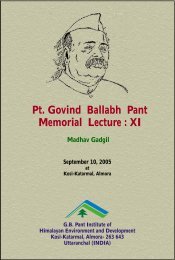Complete Lecture - Govind Ballabh Pant Institute of Himalayan ...
Complete Lecture - Govind Ballabh Pant Institute of Himalayan ...
Complete Lecture - Govind Ballabh Pant Institute of Himalayan ...
Create successful ePaper yourself
Turn your PDF publications into a flip-book with our unique Google optimized e-Paper software.
Andhra Pradesh, Tamil Nadu, West Bengal accoutn for the bulk production, althoughKashmir has much scope as it provides conditions similar to some silk- producingregions in temperate China.The primary food plants <strong>of</strong> tropical tasar worm (Antheraea mylitta) are Terminaliatomentosa and T. arjuna. The secondary hosts are Shorea robusta, Zizyphusmauritiana, Hardwickia binata, Parkia biglandulosa, Dichrostachys cineria that occur inCentral India, Bihar and adjacent states. However, the temperate tasar silkworm (mainlyA. proylei) feeds on the leaves <strong>of</strong> Quercus incana, Q. semecarpifolia, Q. dentata, Q.serrata and Q. himalayana in the sub-montane forests. The temperate silk is also calledthe oak silk. Demands for timber, firewood and fodder are causing a marked reductionin the availability <strong>of</strong> these plants in the <strong>Himalayan</strong> region for the value-added products<strong>of</strong> tasar silk. Conservation measures are necessary for oaks. Eri silkworm (Philosamiasp. Which is a polyphagus moth), is raised on castor been leaves. It has been recentlyshown that the quality that the quality <strong>of</strong> eri silkworm improves if the larvae fed on castorbean leaves are subsequently fed on Ailanthus excelsa (Maharuk) leaves and not viceversa.Tapioca leaves can also be used to feed the eri moths. The eri cocoons are notsuitable for filature and therefore cannot be woven on large looms but are suitable forpreparing mats, coarse material, towelling etc.. The pupae are eaten as a source <strong>of</strong> highprotein.Muga silk which is unique on account <strong>of</strong> its golden yellow fibers is exclusivelyIndian, the moths occurring only in the north-eastern states. The primary hosts <strong>of</strong> themuga silk moth are saulu (Litsea monopetala), som (Machilus bombycina) and champakfor titasopa (Michelia champaca). Secondary hosts include majankari (Litsea citrata),dijloti (L. salicifolia), kathalua (L. nitida), perarichawa (Actinodaphne angustifolia, a.ovata) and bajarmani (Zanthozylum limonella). There is high local and foreign demandfor muga silk. However, the production is as low as 60m tonnes per annum. The nonmulberrysilkworms are not domesticated and have to be collected from the wild by thetribals. There are gaps in our knowledge about the genotypes <strong>of</strong> the plants which aresuitable for high yield or quality yarn.The Department <strong>of</strong> Biotechnology (DBT), Government <strong>of</strong> India has beenchampioning the cause <strong>of</strong> non –mulberry silk in collaboration with the Central Silk Boardand has supported projects to understand the genes that regulate fibroin and sericinsynthesis by the larvae. The DBT has also proposed to set up a conservatory inMeghalaya under the Bioresources Development centre for rearing silk moths that arecommercially used as well as their wild relatives on a wide range <strong>of</strong> host plants.EPILOGUEI was deeply moved by reading the Seventh Memorial lecture in this series byPr<strong>of</strong>. K.S. Valdiya (1997), whom I respect as a friend, humane scientist and adistinguished son <strong>of</strong> the Himalaya. I share his concerns and commitment. I was notprivileged to belong to Himalaya. But Himalaya and Ganga belong to all Indians. It is ourresponsibility to view development as people matter and commit ourselves toconservation and restoration ecology <strong>of</strong> the Himalaya and provide the basic necessities,dignity and pride to the inhabitants. The mountain folk have traditionally led simple lives17











